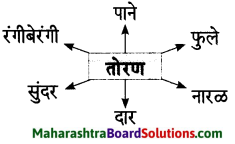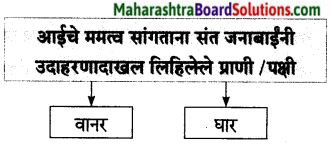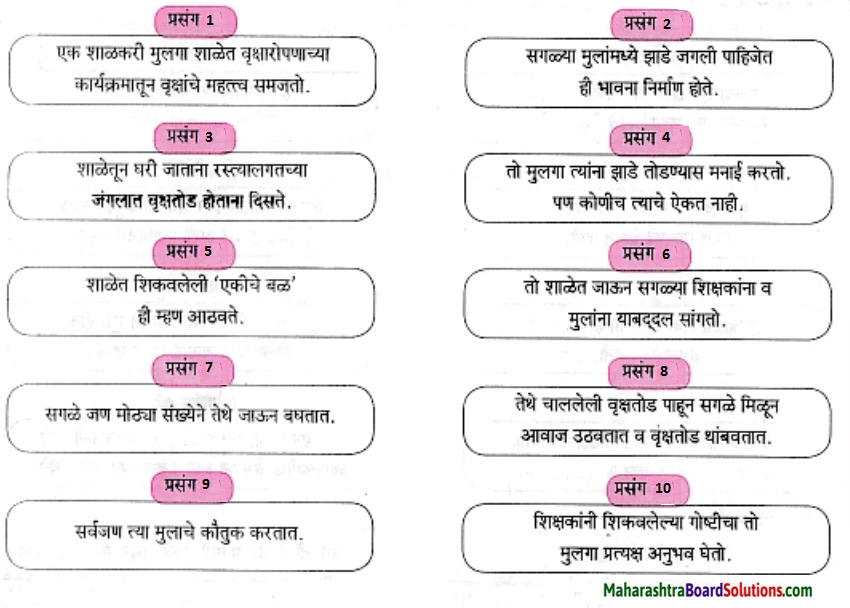Balbharti Maharashtra State Board Class 7 Marathi Solutions Sulabhbharati Chapter 7.1 आजारी पडण्याचा प्रयोग Notes, Textbook Exercise Important Questions and Answers.
Class 7th Marathi Chapter 7.1 आजारी पडण्याचा प्रयोग Question Answer Maharashtra Board
Std 7 Marathi Chapter 7.1 Question Answer
Marathi Sulabhbharti Class 7 Solutions Chapter 7.1 आजारी पडण्याचा प्रयोग Textbook Questions and Answers
1. केव्हा ते लिहा.
प्रश्न अ.
पाठातील मुलाला घरच्यांच्या दुःखात सहभागी व्हावे, असे वाटू लागले.
उत्तर:
आई, दादा, बाबा, ताई आजारी पडले की त्यांना औषध म्हणून संत्री, मोसंबी, सफरचंद, खडीसाखर, बेदाणा, पेढे, गोड औषध मिळायचे. अशक्तपणा आला की शिराही रोज मिळायचा हे सर्व पदार्थ आजारी म्हणून सगळेजण खात असत, पण मुलाला त्या पदार्थांना हात लावायची परवानगी नसायची तेव्हा मुलाला घरच्यांच्या दुःखात सहभागी व्हावे असे वाटू लागले.
![]()
प्रश्न आ.
मुलाने डॉक्टरांकडून औषध आणायचेच, असे ठरवले.
उत्तर:
घरातील मंडळी आजारी असून चांगले पदार्थ खात असत पण मुलाच्या वाटणीला काहीच आजारपण येत नसे. त्यांचा स्वार्थीपणा पाहिला तेव्हा मुलाच्या मनात विचार आला की, आपणही आजारी पडून डॉक्टरांकडून औषध आणायचेच.
प्रश्न इ.
मुलाला धन्य धन्य झाल्यासारखे वाटले.
उत्तर:
जेव्हा मुलाला डॉक्टरांनी तपासले; त्याला इकडे, तिकडे, पालथे वळायला सांगितले; गळ्यातली नळी छातीवर लावली; जीभ बघितली; तेव्हा मुलाला धन्य धन्य झाल्यासारखे वाटले.
प्रश्न ई.
डॉक्टरांचे बोलणे ऐकून मुलाची निराशा झाली.
उत्तर:
“तुला काही झालं नाही. समजलं ना? ठणठणीत आहे तब्येत तुझी, तेव्हा औषध काही नाही. पळ जा घरी.” असे डॉक्टर म्हणाल्यावर मुलाची निराशा झाली.
![]()
2. आकृत्या पूर्ण करा.
प्रश्न 1.
आकृत्या पूर्ण करा.
(अ)

उत्तर:

(आ)

उत्तर:

3. खालील तक्ता पूर्ण करा.
प्रश्न 1.
खालील तक्ता पूर्ण करा.
उत्तर:
| आपण आजारी असताना काय करू शकतो? | आपण आजारी नसताना काय करू शकत नाही? |
| 1. आपण आजारी असताना घरातल्या कामात मदत करू शकत नाही. | 1. घरातल्या कामात मदत करू शकतो. |
| 2. शाळेत जाऊ शकत नाही, अभ्यास करू शकत नाही. | 2. शाळेत जाऊ शकतो, अभ्यास करू शकतो. |
| 3. बाहेरचे पदार्थ खाऊ शकत नाही. | 3. बाहेरचे पदार्थ (योग्य काळजी घेऊन) खाऊ शकतो. |
![]()
4. तुमच्या घरातील एखादी व्यक्ती आजारी पडल्यास तिला मदत म्हणून तुम्ही काय कराल, ते लिहा.
प्रश्न 1.
तुमच्या घरातील एखादी व्यक्ती आजारी पडल्यास तिला मदत म्हणून तुम्ही काय कराल, ते लिहा.
उत्तर:
आमच्या घरातील एखादी व्यक्ती आजारी पडली तर आम्ही खालील प्रमाणे मदत करू:
- आजारी व्यक्तीला दवाखान्यात नेऊ.
- डॉक्टरांच्या सल्ल्यानुसार तिची योग्य अशी काळजी घेऊ.
- तिला वेळेत औषधे देऊ.
- तिला आजारपणात खाण्यास योग्य असे पौष्टिक’ अन्न देऊ.
- तिला अधिकाधिक सोबत करण्याचा प्रयत्न करू.
- तिचे मनोबल वाढवू.
चर्चा करा. सांगा.
पाठामध्ये दुखणेकरी हा शब्द आलेला आहे. दुखणेकरी म्हणजे सतत आजारी पडणारी व्यक्ती. खाली काही वाक्प्रचार व म्हणी दिलेले आहेत. शिक्षक व पालक यांच्याशी चर्चा करून त्यांचा अर्थ समजून घ्या. त्यांचा वाक्यांत उपयोग करा.
- इतिश्री
- छत्तीसचा आकडा
- जमदग्नीचा अवतार
- चोरावर मोर
- लंकेची पार्वती
- कळीचा नारद
- घागरगडचा सुभेदार
- उंटावरचा शहाणा
- गळ्यातला ताईत
![]()
खेळूया शब्दांशी.
(अ) खालील शब्दांना मराठी भाषेतील पर्यायी शब्द लिहा.
(अ) डॉक्टर, (आ) ऑपरेशन, (इ) मेडिसीन, (ई) पेशंट
प्रश्न (अ).
खालील शब्दांना मराठी भाषेतील पर्यायी शब्द लिहा.
(अ) डॉक्टर
(आ) ऑपरेशन
(इ) मेडिसीन
(ई) पेशंट
उत्तर:
(अ) वैदय
(आ) शस्त्रक्रिया
(इ) औषधे
(ई) रुग्ण
![]()
(आ) ‘गुळगुळीत बिछाना’ त्याप्रमाणे खाली दिलेल्या चौकोनातील शब्दांच्या जोड्या जुळवा.
प्रश्न 1.
‘गुळगुळीत बिछाना’ त्याप्रमाणे खाली दिलेल्या चौकोनातील शब्दांच्या जोड्या जुळवा.

उत्तर:
- टवटवीत – फूल
- बटबटीत – डोळे
- चमचमीत – भाजी
- ठणठणीत – आरोग्य
- मिळमिळीत – जेवण
- गुळगुळीत – दगड
![]()
(इ) खाली दिलेल्या चौकोनातील चित्रासंबंधी काही शब्द दिलेले आहेत, त्या शब्दांचा उपयोग करून वाक्ये तयार करा.
प्रश्न 1.
खाली दिलेल्या चौकोनातील चित्रासंबंधी काही शब्द दिलेले आहेत, त्या शब्दांचा उपयोग करून वाक्ये तयार करा.

उत्तर:
- औषधांपासून – औषधांपासून रुग्णाला आराम मिळतो.
- औषधांचा – आजारी माणसाने औषधांचा डोस वेळेत घ्यावा.
- औषधांतून – औषधांतून पाणी मिसळून पिऊ नये.
- औषधांनी – डॉक्टरांनी दिलेल्या औषधांनी मला आराम मिळाला.
- औषधांच्या – औषधांच्या बाटलीवरील / पॅकेटवरील अंतिम तारीख नेहमी बघून घ्यावी.
- औषधांवर – औषधांवरील किंमत बघूनच औषधांच्या दुकानात पैसे द्यावेत.
- औषध – औषधे रुग्णांसाठी वरदान आहे.
- औषधांना – औषधांना नेहमी योग्य तापमानात ठेवावे व योग्य प्रकारे बंद करून ठेवावे.
(ई) कंसात दिलेल्या वाक्प्रचारांच्या उपयोग करुन खालील वाक्ये पूर्ण करा.
(सुचेनासे होणे, सक्त मनाई असणे, फुशारकी मारणे, ठणठणीत असणे)
(अ) सुलेमान चाचा रोज सकाळी फिरायला जातात, त्यामुळे त्यांची तब्येत ……………………. .
(आ) ध्वनीक्षेपकाच्या आवाजामुळे घरात आजोबांना काही ………………………. .
(इ) जॉन आज शाळेत नवीन कंपास घेऊन आला होता. वर्गातील सर्व मुलांना दाखवत तो खूप …………………. होता.
(ई) तो रस्ता खासगी असल्यामुळे आपले वाहन तेथे नेण्याला ……………………. .
उपक्रम : मराठी भाषेत विनोदी लेखन करणाऱ्या लेखकांची व त्यांच्या साहित्याची शिक्षक, पालक यांच्या मदतीने यादी करा. विनोदी गोष्टी वाचा व वर्गात सांगा.
सारे हसूया.
- संजू : मोहन, हे बोटावर आकडे का लिहिलेस?
- मोहन : अरे माझी आजी म्हणते, “नुसत्या बोटावर आकडेमोड करता आली पाहिजे.”
- अजय : थंडी वाजते तेव्हा तू काय करतोस ?
- विजय : मी मेणबत्तीजवळ बसतो.
- अजय : आणि खूप थंडी वाजली तर?
- विजय : मेणबत्ती पेटवतो.
प्रश्न 1.
कंसात दिलेल्या वाक्प्रचारांच्या उपयोग करुन खालील वाक्ये पूर्ण करा.
(सुचेनासे होणे, सक्त मनाई असणे, फुशारकी मारणे, ठणठणीत असणे)
उत्तरः
(अ) सुलेमान चाचा रोज सकाळी फिरायला जातात, त्यामुळे त्यांची तब्येत ठणठणीत असते.
(आ) ध्वनीक्षेपकाच्या आवाजामुळे घरात आजोबांना काही सूचेनासे झाले.
(इ) जॉन आज शाळेत नवीन कंपास घेऊन आला होता. वर्गातील सर्व मुलांना दाखवत तो खूप फुशारकी मारत होता.
(ई) तो रस्ता खासगी असल्यामुळे आपले वाहन तेथे नेण्याला सक्त मनाई आहे.
![]()
संदेश तयार करूया.
1. दवाखाना वा दवाखान्याच्या परिसरात अनेक पाट्या असतात. त्या वाचा. त्यावरील मजकूर खालील रिकाम्या पाटीवर लिहा.

प्रश्न 1.
दवाखाना वा दवाखान्याच्या परिसरात अनेक पाट्या असतात. त्या वाचा. त्यावरील मजकूर खालील रिकाम्या पाटीवर लिहा.
उत्तरः

आपण समजून घेऊया

वरील अधोरेखित शब्द स्वतंत्र नाहीत. वर, बाहेर, पेक्षा हे शब्द अनुक्रमे टेबल, घरटे, विनया या शब्दांना जोडून आले आहेत, म्हणून ती शब्दयोगी अव्यये आहेत. आता, पूर्वी, नंतर, पर्यंत, आत, मागे, शिवाय हीदेखील शब्दयोगी अव्यये आहेत.
जेव्हा शब्दयोगी अव्यये नाम किंवा सर्वनाम यांना जोडून येतात, तेव्हा नामाच्या किंवा सर्वनामाच्या मूळ रूपात बदल होतो. अशा शब्दांना सामान्यरूप म्हणतात. उदा., शाळा-शाळेत, फाटक-फाटकात, रस्तारस्त्याला, मुले-मुलांना.
लक्षात ठेवा : शब्दयोगी अव्यय व क्रियाविशेषण अव्यय यांत फरक आहे.
![]()
खालील वाक्यांतील शब्दयोगी अव्यये अधोरेखित करा.
प्रश्न 1.
खालील वाक्यांतील शब्दयोगी अव्यये अधोरेखित करा.
उत्तरः
- आमच्या शाळेसमोर वडाचे झाड आहे.
- मुलांनी फुगेवाल्याभोवती गर्दी केली.
- आमचा कुत्रा मला नेहमी मित्राप्रमाणे भासतो.
- देशाला देण्यासाठी तुमच्याकडे दहा मिनिटे वेळ आहे का?
Marathi Sulabhbharti Class 7 Solutions Chapter 7.1 आजारी पडण्याचा प्रयोग Important Additional Questions and Answers
खालील वाक्यात रिकाम्या जागी योग्य शब्द लिहा.
प्रश्न 1.
- एखादेही साधे …………….. माझ्या वाटणीला येऊ नये काय?
- ती मंडळी स्वत:च इतक्या वेळा …………………… पडत होती, की माझ्या वाटणीला कोणतेही ……………….. येत नव्हते.
- हळूच मी खुर्चीवर बसलो आणि लोकांकडे ………………… बघू लागलो.
- काही लोक ………………………. होते.
- त्या …………………. खाटेवर’ झोपताना अशी काही मजा वाटली म्हणता?
- डॉक्टरांनी जेव्हा पोटावर एकदम ……………. मारली, तेव्हा तर मला खूप …………………… आले.
- मग क्षणात मनात एक ………………. विचार चमकून गेला.
- त्यांच्या चेहऱ्याकडे ……………… बघू लागलो.
- डॉक्टरांचे हे बोलणे ऐकून माझी फार …………….. .
उत्तर:
- इंजेक्शन
- आजारी, आजारपण
- टकामका
- कण्हत
- गुळगुळीत
- टिचकी, हसायलाच
- धाडसी
- उत्सुकतेने
- निराशा
![]()
खालील वाक्ये कोण कोणास म्हणाले ते लिहा.
प्रश्न 1.
“डॉक्टर मला बरं वाटत नाही हो, मलाही औषध हवं आहे.”
उत्तर:
मुलगा डॉक्टरांना म्हणाला.
प्रश्न 2.
“तुम्हांला ऑपरेशन करता येतं का हो डॉक्टर?”
उत्तर:
मुलगा डॉक्टरांना म्हणाला.
प्रश्न 3.
“अहाहा! ……………, आपल्यालाही स्वतंत्र बाटली मिळायची तर एकूण!”
उत्तर:
मुलगा स्वतःशीच म्हणाला,
![]()
प्रश्न 4.
“डॉक्टर इंजेक्शन क्या बरं का”
उत्तर:
मुलगा डॉक्टरांना म्हणाला.
प्रश्न 5.
“समजलं ना? ठणठणीत आहे तब्येत तुझी.”
उत्तर:
डॉक्टर मुलाला म्हणाले.
प्रश्न 6.
“असं काय हो? क्या ना मला एखादं औषध”
उत्तर:
मुलगा डॉक्टरांना म्हणाला,
खालील प्रश्नांची एका वाक्यात उत्तरे लिहा.
प्रश्न 1.
मुलाला कशाची लाज वाटली?
उत्तरः
आपण एकदाही कधी दुखणेकरी नव्हतो, ही गोष्ट लक्षात आल्यावर मुलाला त्याची लाज वाटली.
![]()
प्रश्न 2.
घरातील सर्वजण आजारी पडल्यावर कोणती छान औषधे असायची?
उत्तर:
घरातील सर्वजण आजारी पडल्यावर, संत्री, मोसंबी. सफरचंद,खडीसाखर, बेदाणा, पेढे ही गोड औषधे असायची.
प्रश्न 3.
चार दिवस आजारी पडून अशक्तपणा आला म्हणजे कोणता पदार्थ व्हायचा?
उत्तर:
चार दिवस आजारी पडून अशक्तपणा आला म्हणजे शिरा रोज व्हायचा.
प्रश्न 4.
मुलाने मनाशी काय ठरवून टाकले?
उत्तर:
मुलाने मनाशी ठरवले की, आपण आजारी पडून डॉक्टरांकडून औषध आणायचेच.
![]()
प्रश्न 5.
मुलाने डॉक्टरांना काय सांगितले?
उत्तर:
मुलाने डॉक्टरांना सांगितले, “डॉक्टर इंजेक्शन या बरं का, ताईला आणि दादाला खूप झालीत आतापर्यंत आता मला पाहिजे. निदान एक तरी.”
खालील प्रश्नांची तीन ते चार वाक्यांत उत्तरे लिहा.
प्रश्न 1.
आपण एकदाही कधी आजारी पडलो नाही, ही गोष्ट मुलाच्या ध्यानात आल्यावर त्याच्या मनात कोणते विचार आले?
उत्तर:
आपण एकदाही कधी आजारी पडलो नाही ही गोष्ट मुलाच्या ध्यानात आल्यावर त्याला त्याची लाज वाटली, त्याच्या मनात आले की आपण एखाददुसऱ्या वेळी तरी आजारी पडायला पाहिजे होते. टायफॉइड, क्षय, न्युमोनिया असली मोठमोठी गोड दुखणी नाही, तर थंडीताप, खोकला, पडसे, पोटदुखी, डोकेदुखी यातले काहीही आपल्या वाटणीला आले नाही. तसेच स्वत:ची औषधाची बाटली, एखादे इंजेक्शनही आपल्या वाटणीला आले नाही.
प्रश्न 2.
आपण घरातील सर्वांबरोबर औषधे घ्यावीत व त्यांच्या दुःखात सहभागी व्हावे, असे मुलाच्या मनात का आले?
उत्तर:
आई, बाबा, दादा, ताई नेहमी आजारी पडायचे त्या सगळ्यांची औषधे मोठी छान असायची. संत्री, मोसंबी, सफरचंद, खडीसाखर, बेदाणा, पेढे, गोड औषधे यांचा सारखा मारा चाललेला असायचा, चार दिवस आजारी पडून अशक्तपणा आला म्हणजे शिराही रोज व्हायचा. हे सगळे पदार्थ ही मंडळी औषध म्हणून खात, पण मुलाला या सर्व पदार्थांना हात लावण्याचीही परवानगी नसायची म्हणून ही औषधे आपणही घ्यावीत व त्यांच्या दुःखात सहभागी व्हावे, असे मुलाच्या मनात आले.
![]()
प्रश्न 3.
मुलगा नेहमीप्रमाणे दवाखान्यात गेल्यावर तेथील लोकांचा त्याला हेवा’ का वाटला?
उत्तर:
मुलगा नेहमीप्रमाणे रोजच्या तीन-चार बाटल्या घेऊन दवाखान्यात गेला तेव्हा, दवाखान्यात खूप गर्दी होती. खूप गर्दी असल्यामुळे त्याला बरे वाटले कारण दवाखान्यात त्यामुळे जास्त वेळ बसायला मिळे. तो खुर्चीवर बसून लोकांकडे टकामका बघू लागला. काही लोक कण्हत होते. कुणी इंजेक्शन घेऊन बसले होते. आपल्या दंडावरील डागाकडे मोठ्या फुशारकीने पाहत होते या सगळ्या गोष्टी त्याच्या वाटेला कधीच आल्या नव्हत्या. म्हणून त्या सर्वांकडे बघून मुलाला त्यांचा हेवा वाटला.
पुढील उतारा वाचून सूचनेनुसार कृती करा.
कृती 1 : आकलन कृती
प्रश्न 1.
आकृतिबंध पूर्ण करा.
उत्तर:

प्रश्न 2.
रिकाम्या जागा भरा.
- डॉक्टर ………….. या बरं का.
- अगदी ……………… आवाजात मी डॉक्टरांना विचारले.
- तुम्हांला ………………….. करता येतं का हो डॉक्टर?
- बराय. आता असं कर, तू …………… खाली.
उत्तर:
- इंजेक्शन
- खासगी
- ऑपरेशन
- उतर
![]()
कृती 2 : आकलन कृती
प्रश्न 1.
चौकट पूर्ण करा.
- पोटावर टिचकी मारल्यावर [ ]
- डॉक्टरांना विचारण्यासाठी केलेला आवाज [ ]
उत्तर:
- हसू आले
- खासगी (येथे अर्थ हळू)
खालील प्रश्नांची एका वाक्यात उत्तरे लिहा.
प्रश्न 1.
कोणाला इंजेक्शन खूप झाली आहेत असं मुलाला वाटतं?
उत्तर:
ताईला आणि दादाला खूप इंजेक्शन झाली आहेत असं मुलाला वाटतं.
![]()
प्रश्न 2.
डॉक्टरांनी ऑपरेशन केलं असतं तर मुलाने काय केलं असतं?
उत्तर:
डॉक्टरांनी ऑपरेशन केलं असतं तर मुलाने पळतपळत घरी जाऊन सगळ्यांना ऑपरेशन दाखवलं असतं.
कृती 3 : व्याकरण कृती
प्रश्न 1.
खालील शब्दांचे वचन बदला.
- खोली
- नळी
- टिचकी
- डॉक्टर
उत्तर:
- खोल्या
- नळया
- टिचक्या
- डॉक्टर
![]()
खालील वाक्यांतील विरामचिन्हे ओळखा.
प्रश्न 1.
डॉक्टर म्हणाले, “हो का?”
उत्तर:
, – स्वल्पविराम, ” ” – दुहेरी अवतरण चिन्ह, ? – प्रश्नचिन्ह
कृती 4 : स्वमत
प्रश्न 1.
आजारी पडण्याचे फायदे व तोटे तुमच्या शब्दांत लिहा.
उत्तर:
आजारी पडल्यामुळे शाळेला सुट्टी मिळते. आजूबाजूची मंडळी आपल्याला भेटायला येतात. येताना फळ किंवा नारळपाणी आणतात. सगळे लाडाने जवळ घेऊन चौकशी करतात व काळजी घेतात. सगळ्यात महत्त्वाचं म्हणजे कुणीच काही काम सांगत नाही. पण फायदयांप्रमाणेच काही तोटेही होतात. ते म्हणजे आजारी असल्यामुळे जेवणाखाण्याची पथ्य पाळावी लागतात. खेळायला जाता येत नाही आणि सगळ्यात महत्त्वाचं म्हणजे डॉक्टरचे इंजेक्शन आणि गोळ्या खाव्या लागतात. मग त्या भितीने आजारीच पडू नये असे वाटू लागते.
![]()
व्याकरण व भाषाभ्यास
प्रश्न 1.
खालील शब्दांचे समानार्थी शब्द लिहा.
- दुखणेकरी
- लाज
- औषध
- निराळी
- ऐट
- जीभ
उत्तर:
- आजारी
- शरम
- दवा
- वेगळी
- रुबाब
- जिव्हा
प्रश्न 2.
खालील शब्दांचे विरुद्धार्थी शब्द लिहा.
- अशक्त
- स्वार्थी
- नाखुश
- उत्सुकता
उत्तर:
- सशक्त
- निस्वार्थी
- खुश
- निरुत्सकता
![]()
प्रश्न 3.
खालील शब्दांचे वचन बदला.
- औषध
- नळी
- पेढा
- बाटली
उत्तर:
- औषधे
- नळ्या
- पेढे
- बाटल्या
प्रश्न 4.
खालील शब्दांचे लिंग बदला.
- आई
- ताई
- डॉक्टर
उत्तर:
- बाबा
- दादा
- डॉक्टरीणबाई
खालील वाक्ये शुद्ध स्वरूपात लिहा.
प्रश्न 1.
अगदी खासगि आवाजात मि डॉक्टरांना वीचारले.
उत्तरः
अगदी खासगी’ आवाजात मी डॉक्टरांना विचारले.
![]()
प्रश्न 2.
त्या गुळगूळीत खाटेवर झोपताना अशी काही मझा वाटली म्हणता!
उत्तरः
त्या गुळगुळीत खाटेवर झोपताना अशी काही मजा वाटली म्हणता!
लेखन विभाग
प्रश्न 1.
मराठी भाषेत विनोदी लेखन करणाऱ्या लेखकांची व त्यांच्या साहित्याची शिक्षक, पालक यांच्या मदतीने यादी करा. विनोदी गोष्टी वाचा व वर्गात सांगा.
उत्तरः
| विनोदी लेखन करणारे लेखक | लेखकांचे साहित्य |
| द. मा. मिरासदार अरूण वि. देशपांडे अनिल अभ्यंकर शं. ना. नवरे सुजित जोशीअरुण सावळेकर विवेक गरुड पु. ल. देशपांडे |
जावईबापूंच्या गोष्टी गजाभाऊ आनंदाचं झाड चोरावर मोर म्या बी शंकर हाय. सुरंगा म्हणतात मला एक अधिक उणे बटाट्याची चाळ |
![]()
प्रश्न 2.
पाठामध्ये दुखणेकरी हा शब्द आलेला आहे. दुखणेकरी म्हणजे सतत आजारी पडणारी व्यक्ती. खाली काही वाक्प्रचार व म्हणी दिलेले आहेत. शिक्षण व पालक यांच्याशी चर्चा करुन त्यांच्या अर्थ समजून घ्या, त्यांचा वाक्यात उपयोग करा.
उत्तरः
1. इतिश्री – सांगता, शेवट.
महाभारताची कौरव पांडवांच्या युद्धानंतर इतिश्री झाली.
2. छत्तीसचा आकडा – शत्रुत्व, वैर असणे.
त्या दोन्ही गावांमध्ये गावच्या हद्दीवरून छत्तीसचा आकडा होता.
3. जमदग्नीचा अवतार – अतिशय रागीट स्वभाव.
भगवान शंकराने तांडव नृत्य करताना जमदग्नीचा अवतार घेतला होता.
4. चोरावर मोर – स्वार्थीपणा करणे.
दोन भावांच्या भांडणात तिसरा भाऊ चोरावर मोर होऊन सर्व संपत्तीचा हक्कदार झाला.
5. लंकेची पार्वती – खूप गरिबी येणे.
साक्षीच्या अंगावर कर्जाचा डोंगर उभा राहिल्यामुळे ती लंकेची पार्वती झाली.
6. कळीचा नारद – इकडच्या गोष्टी तिकडे सांगून भांडणे करणे.
आई व आजीच्या भांडणात तेजश्री कळीचा नारद बनून आपले काम साध्य करत असायची.
7. घागरगडचा सुभेदार – स्वत:ला शहाणा समजणे.
गावाच्या पंचायती समोर प्रभाकर घागरगडचा सुभेदार बनून वावरत असे.
8. उंटावरचा शहाणा – स्वत:बद्दल फाजील अभिमान असणे.
राम आपल्या वर्गात आपला रुबाब दाखवून शिक्षकांसमोर उंटावरच शहाणा बनून राहायचा.
9. गळ्यातला ताईत – खूप लाडके असणे.
नातवंडे आजी आजोबांच्या गळ्यातला ताईत असतात.
![]()
आजारी पडण्याचा प्रयोग Summary in Marathi
पाठ परिचय :
घरातील नेहमी कुणीतरी काही ना काही कारणांमुळे आजारी पडायचे; आपणही असे आजारी पडून आजारी माणसांचे पदार्थ खावे असे मुलाला वाटायचे म्हणून मुलगा डॉक्टरांकडे जातो. दवाखान्यातील आजारी माणसांचा मुलाला खूप हेवा वाटे. ‘तुला औषधाची गरज नाही’ हे डॉक्टरांचे बोलणे ऐकून शेवटी मुलाची निराशा होते. त्याचे आजारपणाबाबतचे असे विचार व दवाखान्यातील वागणे याचे मार्मिक व विनोदी वर्णन ‘आजारी पडण्याचा प्रयोग’ या आपल्या पाठात लेखक द. मा. मिरासदार यांनी केले आहे.
Someone or the other used to fall sick due to different reasons in the house described in this comic write up. The boy also wishes to fall sick and enjoy the food meant for sick people, so he goes to the doctor. He used to always envy sick people in the dispensary. Doctor tells him ‘You don’t need medicines’ and the boy is very disappointed. His thoughts about illness and his behaviour at dispensary have been narrated in the write up by writer D. M. Mirasdar in very comic and subtle language.
![]()
शब्दार्थ :
- दुखणेकरी – आजारी – sick
- लाज – शरम – shame
- पडसे – सर्दी – a common cold
- मालकीची – स्वत:च्या हक्काची – an owner
- अशक्त – दुर्बल, कमजोर – weak
- सक्त – कडक – strict
- चिडणे – रागावणे – to get angry
- टकमका – लोभयुक्त दृष्टीने – looking at
- फुशारकी – ऐट, बढाई – bragging
- ऐट – दिमाख – pomp
- धन्य – कृतकृत्य झालेला – satisfied
- धाडसी – साहसी – adventurous
- विचार – कल्पना – idea
- सूचना – काय करावे वा काय करू नये यासंबंधीची माहिती – suggestion
- नाखूश – अप्रसन्न – displeased
- उत्सुकता – कुतूहल – curiosity
- निराश – खिन्न – disappointed
- रडकुंडी – रडू कोसळण्याची अवस्था – astage of bursting into tears
- टायफॉइड – हिवताप
- क्षय – टीबी
- न्यूमोनिया – अतिसर्दी
- खाट – पलंग – (cot)
- कण्हणे – विव्हळणे – (moaning)
- निराशा – आशाभंग – (despair)
- हेवा – मत्सर, द्वेष – (envy)
- स्वार्थी – आपमतलबी, अप्पलपोटी – (selfish)
- पौष्टिक – पोषणपूर्ण आहार – (Nutritive)
- खाजगी – गुप्त, व्यक्तिगत – (private)
- मजकूर – लिखित भाग – (text)
- प्राधान्य – श्रेष्ठत्व, वरिष्ठत्वाप्रमाणे महत्त्व – (precedence, priority)
![]()
वाक्प्रचार :
- निश्चय करणे – मनाशी पक्के ठरविणे
- ध्यानात येणे – लक्षात येणे
- लाज वाटणे – शरम वाटणे
- सक्त मनाई असणे – बंदी असणे
- ठरवून टाकणे – निश्चित करणे
- धन्य धन्य वाटणे – कृतकृत्य होणे, समाधान वाटणे
- विचार चमकणे – कल्पना सुचणे
- निराशा येणे – आशाभंग होणे
- हेवा वाटणे – मत्सर, असूया वाटणे
- रडकुंडीला येणे – डोळ्यांत अश्रू येणे
- फुशारकी मारणे – बढाई मारणे
Marathi Sulabhbharati Class 7 Solutions
- प्रार्थना Question Answer
- श्यामचे बंधुप्रेम Question Answer
- माझ्या अंगणात (कविता) Question Answer
- गोपाळचे शौर्य Question Answer
- दादास पत्र Question Answer
- आम्ही सूचनाफलक वाचतो Question Answer
- टप् टप् पडती (कविता) Question Answer
- आजारी पडण्याचा प्रयोग Question Answer
- आपली समस्या आपले उपाय – १ Question Answer































